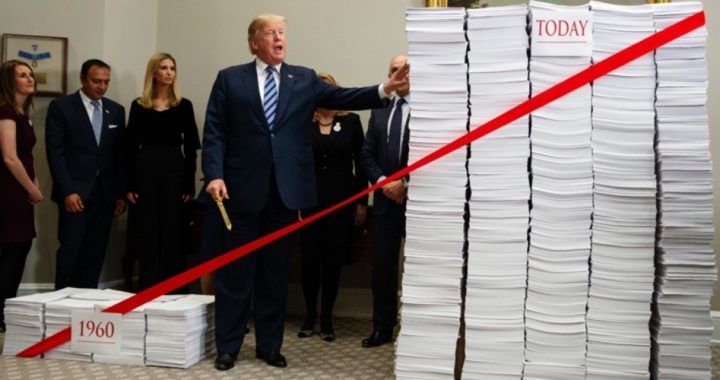
In his first 11 months in office, President Donald Trump is keeping another of his campaign promises: reducing regulations so that the economy can breathe again. Speaking in the Roosevelt Room — an irony that may have been intended — Trump summarized brilliantly exactly how the greatest economic miracle in history got bogged down:
Congress has abandoned much of its responsibility to legislate [see Article I, Section I of the U.S. Constitution: “All legislative powers herein granted shall be vested in a Congress of the United States”], and has instead given unelected regulators … extraordinary power to control the lives of others. The courts have let this massive power grab go almost completely unchecked and have almost always ruled in favor of big government. With billions and billions of dollars wasted, regulation is a stealth taxation. So many of these enormous regulatory burdens were imposed on our citizens with no vote, no debate, and no accountability.
It has been helped along with civil service regulations that virtually guaranteed that no federal government bureaucrat could be fired. Paul Light, professor of public service at New York University, explained: “Very few federal employees — in the hundreds, not the thousands — are ever fired on the basis of performance. That’s out of a federal workforce of [nearly 2 million].” A government agency appointed to look into the problem concluded that the process required to fire a civil servant was “horrendous” and that nearly every supervisor trying to get rid of an unproductive worker just gave up out of frustration.
Rather than take on the ossified civil service structure directly, the president had a better idea: require each agency to retire two regulations for every new one. As chief executive, he could provide this regulatory relief. With the help of a remarkably capable but largely unsung appointee, Trump has far exceeded even his own expectations. Explained the president:
One of the very first actions of my administration was to impose at two-for-one rule on new federal regulations. We ordered that for every one new regulation, two old regulations must be eliminated … as a result, the never-ending growth of red tape in America has come to a sudden screeching and beautiful halt….
Within our first 11 months, we cancelled or delayed over 1,500 planned regulatory actions — more than any previous President by far….
And instead of eliminating two old regulations, for everyone new regulation we have eliminated 22 — 22. That’s a big difference. We aimed for two-for-one and, in 2017, we hit twenty-two-for one.
And just who is this invisible unsung heroine? Her name is Neomi Rao, whose official title inside Trump’s Office of Management and Budget (OMB) is Administrator of the Office of Information and Regulatory Affairs. Surprisingly she is a graduate of Yale and the University of Chicago Law School and has served as executive editor of the Harvard Journal of Law and Public Policy, but she never drank the regulatory Kool-Aid. In April, when Trump nominated her to her present position, Jonathan Adler, an incisive contributor to the widely read and highly regarded weblog “The Volokh Conspiracy,” wrote that “Trump’s selection of Rao suggests his administration is serious about regulatory reform, not merely reducing high-profile regulatory burdens.”
Almost immediately following Trump’s announcement of his twenty-two-for-one regulatory rollback, Rao took the microphone and dispelled any lingering doubts about her intentions:
From my perspective, a lot of this is linked to individual freedom. When the government is interfering less in people’s lives, they have a greater opportunity to pursue their goals. I also think that what we’re doing here is connected to making government more constitutional.
For the first 11 months of the Trump administration, Rao said there were 67 deregulatory actions and just 3 new regulatory actions. And that’s just the beginning.
She was quizzed about just how far back those rollbacks might go. She reiterated Trump’s suggestion that 1960 might be a good goal. Said the president: “In 1960, there were approximately 20,000 pages in the Code of Federal Regulations. Today, there are over 185,000 pages … we’re getting back below the 1960-level, and we’ll be there fairly quickly.” For 2018, said Rao, “We’re on track to continue to be better than three-for-one … [our] agenda reflects 448 deregulatory actions and 131 regulatory actions … so we’re planning to keep up the deregulatory efforts.”
Rao touted compliance cost reductions already in the billions, with more billions to be cut in the future. But the real result isn’t the cutting of regulations, it’s the release of pressure on entrepreneurs and small business owners, whose fear of more and more regulations under Obama kept them from starting new companies or expanding existing ones. Today they are breathing more easily and making plans for expansion, taking in the oxygen of the new climate of freedom.
Photo of Trump about to cut ribbon on stacks of paper representing federal regulatory code: AP Images
An Ivy League graduate and former investment advisor, Bob is a regular contributor to The New American magazine and blogs frequently at LightFromTheRight.com, primarily on economics and politics. He can be reached at [email protected].



